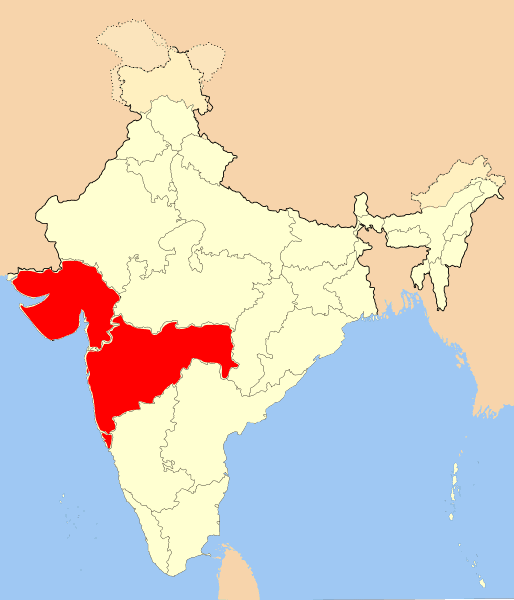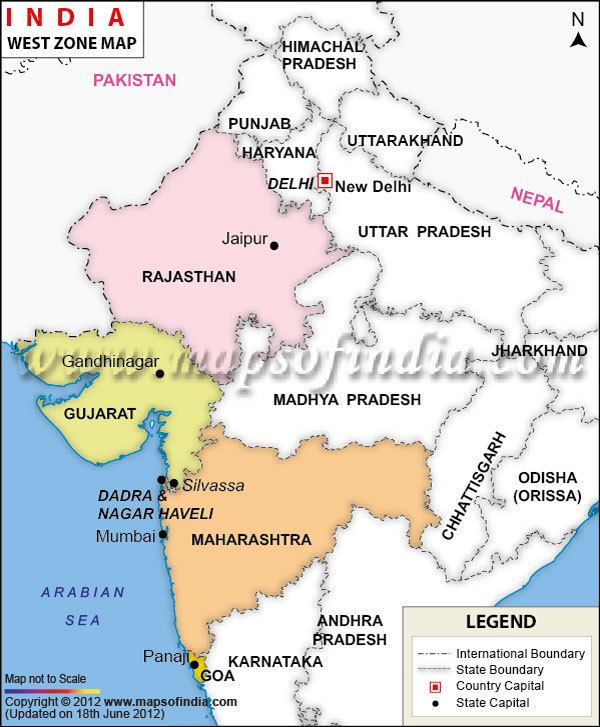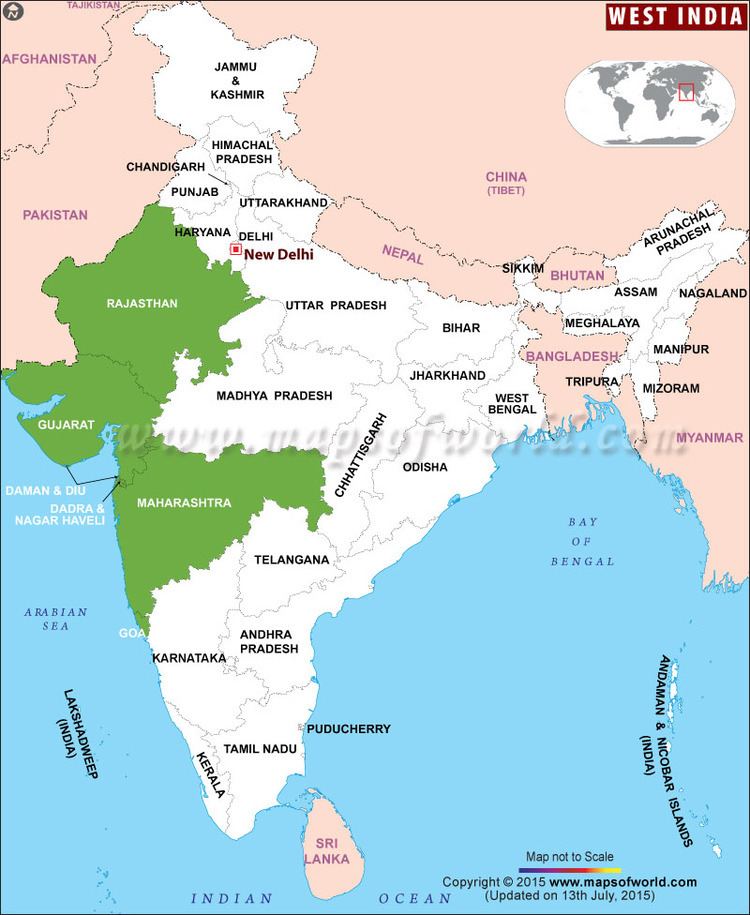Country India Area 508,032 km² | ||
 | ||
States and territories GoaGujaratMaharashtraDadra and Nagar HaveliDaman and Diu Most populous cities (2011) Goa:MormugaoMargaoMapusaPanajiCurchoremGujarat:AhmedabadSuratVadodaraRajkotJamnagarMaharashtra:MumbaiPuneNagpurThanePimpri-Chinchwad Official languages GujaratiKonkaniMarathiHindiEnglish | ||
Western india nature tours and travels
Western India consists of the states of Goa, Gujarat, and Maharashtra along with the Union territory of Daman and Diu and Dadra and Nagar Haveli of India. The region is highly industrialized, with a large urban population. Roughly, Western India is bounded by the Thar Desert in the northwest, the Vindhya Range in the north and the Arabian Sea in the west. A major portion of Western India shares the Deccan Plateau with South India. Before the partition of India, the now-Pakistani territories of Sindh and Balochistan were also included in this region.
Contents
- Western india nature tours and travels
- History
- Geography
- Climate
- Demographics
- Culture
- Cuisine
- Economy
- References

History

Parts of Gujarat were the site of Indus Valley Civilization. places have been uncovered in Gujarat at Lothal, Surkotada, and around Ghaggar river in Rajasthan. The Western Indian region was ruled by the Rashtrakuta Empire, the Maurya Kingdom, Gurjars, Rajputs, Satavahanas, Western Satraps, Indo Greeks, Kadambas etc. in the ancients times. During the medieval age, the region came under Persian influence and also under Mughal rule. Later, the Maratha Empire which arose in western Maharashtra came to dominate a major portion of the Indian sub-continent. However its defeat by the British in the Anglo-Maratha wars left most of India under colonial rule. The region then experienced great upheavals during the struggle for Indian Independence. Gandhi's Dandi March took place in Gujarat. The region became part of independent India in 1947, and the present state boundaries were drawn based on linguistic considerations in 1956.
Geography

The region consists of the predominantly arid to semi-arid region of Saurashtra and Kutch in the North. The region South of that of Cambay and Southern Gujarat makes the northern semi arid region and the southern humid region submerge, though this region itself being the humid to sub humid. The Western Ghats and Konkan lie along the coast of Maharashtra and Goa. The Deccan plains of the Vidarbha, Marathwada in central and eastern Maharashtra define the rest of the region. The vegetation varies from tropical rainforests along the Konkan coast to thorny bushes and shrubs in northern Gujarat. The rivers in this region are the Narmada, Tapi, Godavari, Zuari, Mandovi, Krishna, Ghaggar, Chambal and many other smaller tributaries of other rivers.
Climate

The climate varies between tropical wet, tropical wet and dry, and semi arid. The coastal regions experience little seasonal variations although the temperatures range between 20 °C to 38 °C. Mumbai and northern Konkan regions experience cooler winters with minimum temperatures hovering around 12 °C. Interior Maharashtra experiences hot summers with maximum temperatures averaging 40 °C and mild winters with minimum temperatures averaging about 10 °C. Pune, a city in the western region experiences temperatures around 40-42 °C in summers and 6-7 °C on winters. Gujarat also has a warm climate with hot summers and cool winters.
Demographics

The majority follow Hinduism and there are significant minority who follow Islam and smaller number who follow Christianity. There are also a few indigenous Jews called the Bene Israel who speak Marathi. The Parsees who settled in Gujarat made Mumbai and Surat their home. Significant percentages of Jains and Buddhists can be found too. Most Christians live in the state of Goa.

Overall, 83.66% of the population is Hindu, 10.12% Muslim, 4% Buddhist with Christians in Goa and Maharashtra making up the majority of the remainder. Marathi, with about 73 million speakers is the most widely spoken language, followed by Gujarati with about 46 million speakers and Konkani 2.5 million speakers, all of which are Indo-Aryan languages. As in other parts of India, a high level of multilingualism is seen with English and Hindi being spoken as additional languages in urban areas.

The average literacy rate of West India is around 76%, higher than the national average of 70.5%. The population density is around 290 per square km. The average fertility rate is about 2.2, while the average household size is about 4.7.
Culture
The states of Maharashtra, Gujarat and Goa are culturally varied and distinct.
Maharashtrian culture derives from the ancient Hindu Vedic culture influenced deeply by the Maratha Empire. Maharashtrians take great pride in the Maratha Empire, and many places in Maharashtra are named after the founder of the Empire, Shivaji. Marathi literature and cinema are popular in the state as well as across India. Bollywood has had a huge impact on the lifestyle and culture of this part of India as the industry is primarily located in Mumbai.
Gujarati culture is a blend of Indian culture and foreign influence. It has been influenced by the Parsis, who migrated to Gujarat from Persia about a 1000 years ago. Gujarat also saw Turkic and Mughal conquests, as well as a constant stream of back-forth migrations to and from Sindh and Rajasthan, which helped shape the unique cultural landscape of the state. Cultural Events like Rann Utsav, International Kite Festival and Global Garba festivals have been started in Gujarat to showcase its culture internationally.
Goan culture is a unique blend of Indian and Portuguese cultures, as a result of it formerly being part of Portuguese India for 450 years. The state is popular amongst tourists for its beaches, Goan cuisine, temples, churches and architecture. The Churches and Convents of Goa have been declared as a World Heritage Site by UNESCO.
Cuisine
The cuisine of Western India is diverse. Surat City Of Gujarat is Worldwide Known For Food, Maharashtrian cuisine is diverse and ranges from bland to fiery hot. Pohay, Shrikhand, Pav Bhaji, Vada Pav are good examples of Maharashtrian cuisine. Goan cuisine is dominated by the use of rice, coconut, seafood, Kokum, cashew-nuts.With its distinct spices and medium of cooking as coconut oil, both vegetarian as well as non-vegetarian cuisine is equally popular. Gujarati cuisine is almost exclusively vegetarian. Gujarat is one of three states in India, with prohibition on alcohol, along with Mizoram and Manipur. In contrast, Maharashtra has some of the best vineyards in India, with Nashik and Sangli districts being the country's biggest grape-producing districts.
Economy
This region contributes 24.00% to the country's national GDP, experiencing an annual growth rate of 14.5% as of 2006. It is responsible for approximately 23% of the nation's tax revenues. Access to electricity is available to over 85% of households, and about 55% possess a television. The primary source of employment in the area is agriculture, although the services sector accounts for the largest portion of the region's total GDP.
